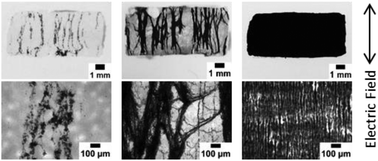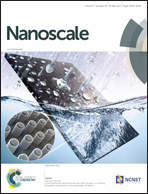Tuning electric field aligned CNT architectures via chemistry, morphology, and sonication from micro to macroscopic scale†
Abstract
Electric-field alignment of carbon nanotubes (CNT) is widely used to produce composite materials with anisotropic mechanical, electrical, and optical properties. Nevertheless, consistent results are difficult to achieve, and even under identical electric field conditions the resulting aligned morphologies can vary over μm to cm length scales. In order to improve reproducibility, this study addresses (1) how solution processing steps (oxidation, sonication) affect CNT properties, and (2) how CNT chemistry, morphology, and dispersion influence alignment. Aligned CNT were deposited onto PVDF membranes using a combination of electric-field alignment and vacuum-filtration. At each step in solution processing, the CNT chemistry (oxygen content) and morphology (length/diameter) were characterized and compared to the final aligned morphology. Well-dispersed CNT with high oxygen content (>8.5%O) yielded uniform membrane coatings and microscopically aligned CNT, whereas CNT with low oxygen CNT (<2.2%O) produced aligned bundles visible at a macroscopic level, but microscopically the individual CNT remained disordered. Based on regression analysis, CNT with larger mean length and diameter, smaller length and diameter variation, and higher oxygen content yielded increased electrical anisotropy, and bath sonication was slightly preferable to probe sonication for initial dispersion.



 Please wait while we load your content...
Please wait while we load your content...